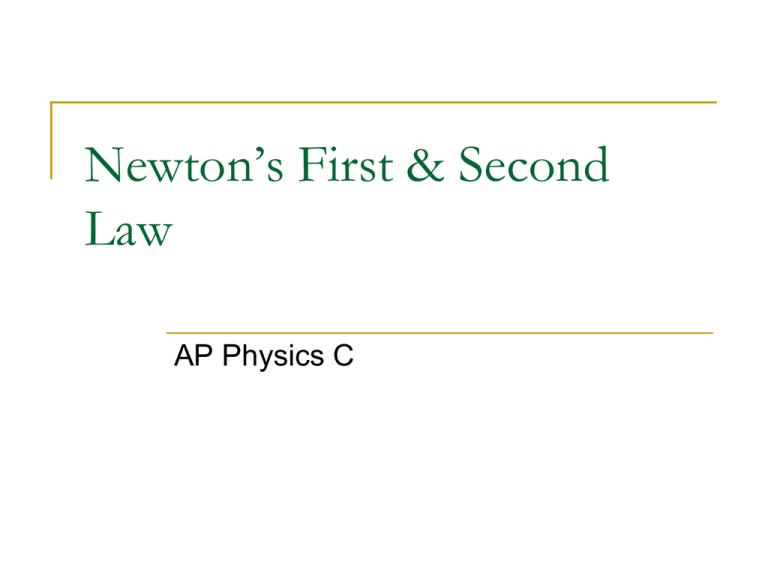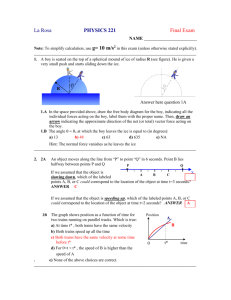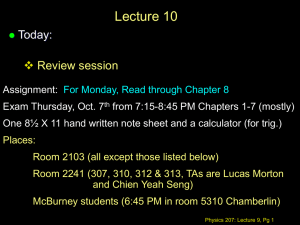Newton`s Laws Powerpoin
advertisement

Newton’s First & Second Law AP Physics C • • • • Unit is the NEWTON(N) Is by definition a push or a pull Can exist during physical contact(Tension, Friction, Applied Force) Can exist with NO physical contact, called FIELD FORCES ( gravitational, electric, etc) INERTIA – a quantity of matter, also called MASS. Italian for “LAZY”. Unit for MASS = kilogram. Weight or Force due to Gravity is how your MASS is effected by gravity. W mg NOTE: MASS and WEIGHT are NOT the same thing. MASS never changes When an object moves to a different planet. What is the weight of an 85.3-kg person on earth? On Mars=3.2 m/s/s)? W mg W ( 85 . 3 )( 9 . 8 ) 835 . 94 N W MARS ( 85 . 3 )( 3 . 2 ) 272 . 96 N Example Problem Sam weighs 270 N on Mercury, and Andy weighs 530 N on Venus. Who has a larger mass? The acceleration due to gravity on Mercury is 3.59 m/s2 and the acceleration due to gravity for Venus is 8.87 m/s2. An object in motion remains in motion in a straight line and at a constant speed OR an object at rest remains at rest, UNLESS acted upon by an EXTERNAL (unbalanced) Force. There are TWO conditions here and one constraint. Condition #1 – The object CAN move but must be at a CONSTANT SPEED Condition #2 – The object is at REST Constraint – As long as the forces are BALANCED!!!!! And if all the forces are balanced the SUM of all the forces is ZERO. The bottom line: There is NO ACCELERATION in this case AND the object must be at EQILIBRIUM ( All the forces cancel out). acc 0 F 0 Explain Inertia in each of the following situations: Crash Dummy http://www.cleanvideosearch.com/media/action/yt/watch?videoId=d7iYZPp2 zYY Football /Ref http://www.youtube.com/watch?v=qLp6qH1Izxw Cat http://www.youtube.com/watch?v=xlcL-n-6U-o Cheetah http://www.youtube.com/watch?v=pWWtngjd4oI Working in Space and Inertia http://www.sciencewithmrnoon.com/physics/unit03.htm Straw in Plywood http://www.physics.umd.edu/lecdem/services/demos/demosc3/c3-12.htm Masses on String http://www.physics.umd.edu/lecdem/services/demos/demosc3/c3-03.htm A pictorial representation of forces complete with labels. FN Ff T T W1,Fg1 or m1g m2g •Weight(mg) – Always drawn from the center, straight down •Force Normal(FN) – A surface force always drawn perpendicular to a surface. •Tension(T or FT) – force in ropes and always drawn AWAY from object. •Friction(Ff)- Always drawn opposing the motion. Ff FN mg Normal force The force that keeps one object from invading another object is called the normal force “Normal” means “perpendicular” You can determine the normal force by considering all forces that have components perpendicular to a surface A 10-kg box is being pulled across the table to the right at a constant speed with a force of 50N. a) b) Calculate the Force of Friction Calculate the Force Normal FN Ff mg Fa F a F f 50 N mg Fn (10 )( 9 . 8 ) 98 N Suppose the same box is now pulled at an angle of 30 degrees above the horizontal. a) Calculate the Force of Friction b) Calculate the Force Normal Fax Fa cos 50 cos 30 43 . 3 N F f Fax 43 . 3 N FN Ff Fa Fay 30 Fax mg F N mg ! F N F ay mg F N mg F ay (10 )( 9 . 8 ) 50 sin 30 F N 73 N Tension A pulling force. Generally exists in a rope, string, or cable. Arises at the molecular level, when a rope, string, or cable resists being pulled apart. Tension (static 2D) The sum of the horizontal and vertical components of the tension are equal to zero if the system is not accelerating. 30o 45o 1 2 3 15 kg Problem: Determine the tension in all three ropes. 30o 45o 1 2 3 15 kg T1 = 131 N T2 = 107 N T3 = 147 N Friction Friction is a force that exists between two surfaces that opposes a sliding motion Fs: Static friction exists before sliding occurs, it prevents movement Fk: Kinetic friction exists after sliding occurs, it opposes motion once objects are moving • Ff is directly proportional to Fn (normal force): F f Fn Ff Fn • Coefficient of friction (): – Determined by the nature of the surfaces – s is for static friction. – k is for kinetic friction. – s > k two μ Typical Coefficients of Friction Values for have no units and are approximate Now Try These Phun Phree Body Diagrams A block pulled to the right on a rough horizontal surface Fn Fk Fn A block pulled up a rough incline Fa Fg Fa Fk Fg Two blocks in contact with each other, pushed to the right on a frictionless surface P’ Fn Fn Fa P Fg Two blocks connected by a cord, one is on top of the table, the other is hanging off the side. The table surface is rough, the pulley is frictionless Fg Fn Fk T T Fg Fg Classroom Practice Problem What is the Frictional force in this situation? EXPLAIN Mass of the block is 500 g Force applied is 3 N. = 0.75 The Block is stationary Sample problem: A 1.00 kg book is held against a wall by pressing it against the wall with a force of 50.00 N. What must be the minimum coefficient of friction between the book and the wall, such that the book does not slide down the wall? μs = .196 F Since the Fnet = 0, a system moving at a constant speed or at rest MUST be at EQUILIBRIUM. TIPS for solving problems • Draw a FBD • Resolve anything into COMPONENTS • Write equations of equilibrium • Solve for unknowns If an object is NOT at rest or moving at a constant speed, that means the FORCES are UNBALANCED. One force(s) in a certain direction over power the others. THE OBJECT WILL THEN ACCELERATE. The acceleration of an object is directly proportional to the NET FORCE and inversely proportional to the mass. a F NET a F NET m a 1 F NET F m F NET ma Tips: •Draw an FBD •Resolve vectors into components •Write equations of motion by adding and subtracting vectors to find the NET FORCE. •Solve for any unknowns A 10-kg box is being pulled across the table to the right by a rope with an applied force of 50N. Calculate the acceleration of the box if a 12 N frictional force acts upon it. FN Ff mg Fa In which direction, is this object accelerating? The X direction! So N.S.L. is worked out using the forces in the “x” direction only F Net ma F a F f ma 50 12 10 a a 3 .8 m / s 2 Problem: A hockey puck has an initial velocity of 20 m/s. If the puck slide 115m before coming to a stop, what is the coefficient of kinetic friction between the puck and the ice? μk = .196 A mass, m1 = 3.00kg, is resting on a frictionless horizontal table is connected to a cable that passes over a pulley and then is fastened to a hanging mass, m2 = 11.0 kg as shown below. Find the acceleration of each mass and the tension in the cable. FN F Net ma T m2 g T m2a T m1a T m 2 g m1a m 2 a m1g m 2 g m 2 a m1a m 2 g a ( m 2 m1 ) m2g a m2g m1 m 2 (11 )( 9 . 8 ) 14 7 .7 m / s 2 F Net ma T ( 3 )( 7 . 7 ) 23 . 1 N m2 g T m2a T m1a F Net ma Slope Rise Run F NET a m Non-constant Forces Up until this time, we have mainly dealt with forces that are constant. These produce a uniform, constant acceleration. Kinematic equations can be used with these forces. However, not all forces are constant. • Forces can vary with time, velocity, and with position. The Derivative • • The derivative yields tangent lines and slopes We use the derivative to go from • The Integral • • The integral yields the area under a curve Use the integral to go from • position -> velocity -> acceleration acceleration -> velocity -> position In these two approaches, F = ma, so methods for determining or using acceleration are also used to find force Where does the calculus fit in? 2 dv d x F ma m m dt dt There could be situations where you are given a displacement function or velocity function. The derivative will need to be taken once or twice in order to get the acceleration. Here is an example. You are standing on a bathroom scale in an elevator in a tall building. Your mass is 72-kg. The elevator starts from rest and travels upward with a speed that varies with time according to: 2 v ( t ) 3t 0 . 20 t When t = 4.0s , what is the reading on the bathroom scale (a.k.a. Force Normal)? F net ma a dv dt d ( 3 t 0 . 20 t ) 2 3 0 . 40 t dt a ( 4 ) 3 0 . 40 ( 4 ) 4.6 m/s/s F N mg ma F N ma mg F N ( 72 )( 9 . 8 ) ( 72 )( 4 . 6 ) 1036.8 N Consider a force that is a function of time: ◦ F(t) = (3.0 t – 0.5 t2)N If this force acts upon a 0.2 kg particle at rest for 3.0 seconds, what is the resulting velocity and position of the particle? vf = 45 m/s xf = 50.6 m Sample problem: Consider a force that is a function of time: F(t) = (16 t2 – 8 t + 4)N If this force acts upon a 4 kg particle at rest for 1.0 seconds, what is the resulting change in velocity of the particle? Δv = 1.33 m/s











